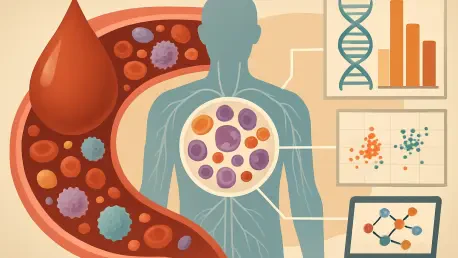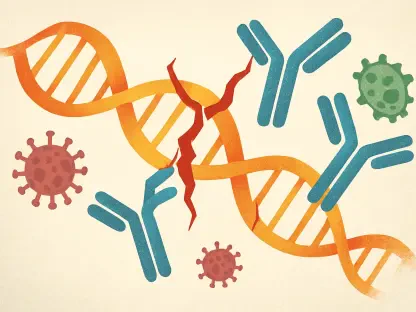In a world where medical breakthroughs are reshaping the boundaries of healthcare, the Human Disease Blood Atlas stands as a monumental achievement that could redefine how diseases are understood and treated. Spearheaded by Dr. Mathias Uhlén and a dedicated team of over 100 international researchers, this atlas meticulously maps around 5,400 proteins in the blood across 59 distinct diseases, drawing data from more than 8,000 individuals. Far from being a mere catalog of biological data, this innovative resource emerges as a game-changer in precision medicine, offering unprecedented insights into human biology. It holds the promise of detecting diseases at their earliest stages and customizing treatments to fit individual needs. This article delves into the profound implications of this scientific milestone, exploring how it transforms the landscape of medical research and patient care through a systems-based approach, cutting-edge technology, and a vision for personalized healthcare.
Pioneering a Systems-Based Approach
The Human Disease Blood Atlas marks a significant departure from the conventional methods of biomarker research, which often focused on isolating single indicators by comparing diseased individuals to healthy controls. Such traditional approaches frequently struggled to separate specific disease signals from broader physiological responses like inflammation or tissue damage. By contrast, the atlas introduces a comprehensive, side-by-side comparison of protein profiles across a diverse spectrum of conditions. This panoramic perspective unveils distinct “protein fingerprints” for each disease, allowing researchers to discern unique molecular signatures while also identifying shared biological patterns. The result is a richer, more nuanced understanding of how diseases manifest and interact at a molecular level, setting a new standard for diagnostic accuracy and opening doors to innovative therapeutic strategies that address the root causes of illness rather than just symptoms.
Beyond simply identifying unique disease markers, this systems-based methodology fosters a deeper comprehension of the interconnected nature of human health. The atlas reveals how certain biological pathways, such as inflammation, are common across multiple conditions, while others remain specific to particular diseases. This dual focus helps clarify long-standing ambiguities in medical research, where general responses were often mistaken for disease-specific indicators. For researchers and clinicians, this means a shift toward more targeted investigations and interventions, reducing the risk of misdiagnosis. Additionally, the atlas serves as a vital resource for studying the complex interplay between different diseases, potentially uncovering links that were previously obscured by fragmented research approaches. As a publicly accessible tool, it empowers the global scientific community to build on these findings, accelerating progress in understanding the intricate web of human biology.
Leveraging Advanced Technological Innovations
Underpinning the remarkable capabilities of the Blood Atlas is a synergy of state-of-the-art technology and sophisticated data analysis. The project utilizes next-generation proximity extension assay technology, a highly sensitive method that employs DNA-labeled antibodies to detect and quantify thousands of proteins simultaneously within blood samples. This approach enables an extraordinary level of precision in mapping the circulating proteome, capturing detailed molecular profiles that were once beyond reach. When paired with artificial intelligence models, the technology sifts through vast datasets—covering approximately 5,400 proteins across over 8,000 individuals—to distinguish meaningful disease-specific signals from background noise. This fusion of innovation provides a clearer picture of both healthy baselines and pathological states, laying a robust foundation for medical advancements.
The technological prowess of the atlas extends beyond mere data collection to transformative analysis that reshapes research possibilities. Artificial intelligence plays a crucial role in processing the immense volume of information generated, identifying patterns and correlations that human analysis might overlook. This capability is particularly vital when dealing with the complexity of the human proteome, where subtle variations can hold significant diagnostic value. By automating and enhancing the interpretation of protein profiles, the atlas not only accelerates the pace of discovery but also ensures greater accuracy in pinpointing biomarkers. For the scientific community, this represents a leap forward in handling large-scale biological data, offering tools to explore disease mechanisms with unprecedented depth. The implications are far-reaching, promising to refine how medical research is conducted and how quickly new insights can be translated into practical applications.
Transforming the Landscape of Precision Medicine
The Blood Atlas is more than a research milestone; it embodies a visionary blueprint for the future of healthcare delivery. Dr. Uhlén envisions a paradigm where regular blood profiling becomes an integral part of routine health assessments, tracking an individual’s “molecular fingerprint of wellness” over time. Such a system could detect deviations indicative of diseases like cancer long before symptoms become apparent, enabling early interventions that dramatically improve outcomes. This proactive approach shifts the focus from reactive treatment to preventive care, potentially saving countless lives through timely action. Furthermore, by providing a detailed molecular map, the atlas equips clinicians to design personalized treatment plans tailored to a patient’s unique biological profile, enhancing the effectiveness of therapies and minimizing adverse effects.
In addition to early detection, the atlas offers a dynamic tool for monitoring treatment progress and adjusting care strategies in real time. By continuously tracking molecular changes in the blood, healthcare providers can assess how well a therapy is working and make data-driven decisions to optimize outcomes. This capability is particularly transformative for chronic conditions and complex diseases, where treatment responses can vary widely among patients. The atlas also holds potential for stratifying patients into subgroups based on their protein profiles, ensuring that therapies are matched to those most likely to benefit. While the full realization of this vision requires further validation, the groundwork laid by the atlas signals a fundamental shift in how medicine is practiced, moving toward a model where individual health data drives every aspect of care with precision and foresight.
Unlocking Early Detection and Personalized Care
Among the most compelling promises of the Blood Atlas is its ability to facilitate early detection of life-threatening conditions. The study identified specific protein changes associated with cancers such as lung and ovarian, suggesting that these diseases could be identified years before clinical symptoms emerge. This early warning system could revolutionize outcomes by enabling interventions at stages when diseases are most treatable. Beyond oncology, the atlas provides a baseline of healthy blood profiles, documenting stable protein patterns in individuals over time. This reference point allows for the identification of deviations that may signal the onset of health issues, offering a personalized lens through which to monitor well-being and act swiftly when anomalies are detected, thus redefining preventive healthcare.
Equally significant is the atlas’s contribution to understanding the dynamic nature of human biology across different life stages and demographics. The research highlights notable shifts in the proteome during periods like puberty and distinct differences between genders, illustrating how biological profiles evolve. This knowledge equips medical professionals with the tools to interpret blood data in context, accounting for natural variations rather than misattributing them to disease. Such personalized insights ensure that health assessments are not one-size-fits-all but tailored to an individual’s unique biological makeup. By establishing a comprehensive view of both health and disease, the atlas paves the way for interventions that are not only reactive to illness but also proactive in maintaining wellness, offering a more holistic approach to patient care that prioritizes precision at every step.
Addressing the Limits of Traditional Biomarkers
A critical insight from the Blood Atlas is the inadequacy of traditional inflammation markers as reliable indicators of specific diseases. While these markers often show elevated levels across a range of conditions, they lack the specificity required for precise diagnosis, often leading to confusion in clinical settings. The atlas brings much-needed clarity by distinguishing between broad inflammatory responses and unique molecular signatures tied to particular diseases. This differentiation is essential for developing diagnostic tools that accurately pinpoint conditions rather than merely flagging general health disturbances. By redefining the role of inflammation in disease profiling, the atlas challenges long-held assumptions and sets a new benchmark for biomarker research.
This nuanced perspective on biomarkers has profound implications for how diagnostic tools are designed and validated. With the comprehensive data provided by the atlas, researchers can move beyond generic indicators to focus on targeted protein profiles that truly reflect disease states. This shift could overhaul countless studies and clinical practices that have relied on less specific markers, reducing diagnostic errors and improving patient outcomes. Moreover, the atlas’s ability to map overlapping pathways across diseases offers a clearer understanding of shared mechanisms, guiding the development of therapies that address common underlying factors. As a result, the scientific community is prompted to reevaluate existing approaches, ensuring that future innovations in diagnostics are grounded in the detailed, systems-level insights that the atlas provides.
Laying the Groundwork for Tomorrow’s Healthcare
Looking ahead, the Blood Atlas envisions a future where blood profiling is seamlessly integrated into routine healthcare practices. The concept of annual blood tests to monitor an individual’s molecular profile as a personalized health benchmark is a compelling one, promising to catch potential issues before they escalate. However, translating this vision into reality involves navigating significant hurdles, including rigorous clinical validation and adherence to stringent regulatory standards—a process that may extend over several years. Despite these challenges, the atlas’s status as an open-access resource already empowers researchers worldwide to delve into disease mechanisms and innovate diagnostic solutions, fostering a collaborative environment that accelerates medical progress.
Reflecting on the journey, the development of the Blood Atlas stands as a testament to what was achieved through collective scientific endeavor and technological innovation. Its comprehensive mapping of proteins across numerous conditions provided a foundation for distinguishing disease-specific signals from common responses. This effort not only enhanced the understanding of human biology but also set a precedent for how integrative datasets could transform healthcare. As the atlas continues to inspire research, the focus must remain on bridging the gap between discovery and application. Strategic partnerships, sustained funding, and a commitment to overcoming regulatory obstacles will be essential to ensure that the benefits of blood profiling reach patients globally, heralding an era of truly personalized medicine.









